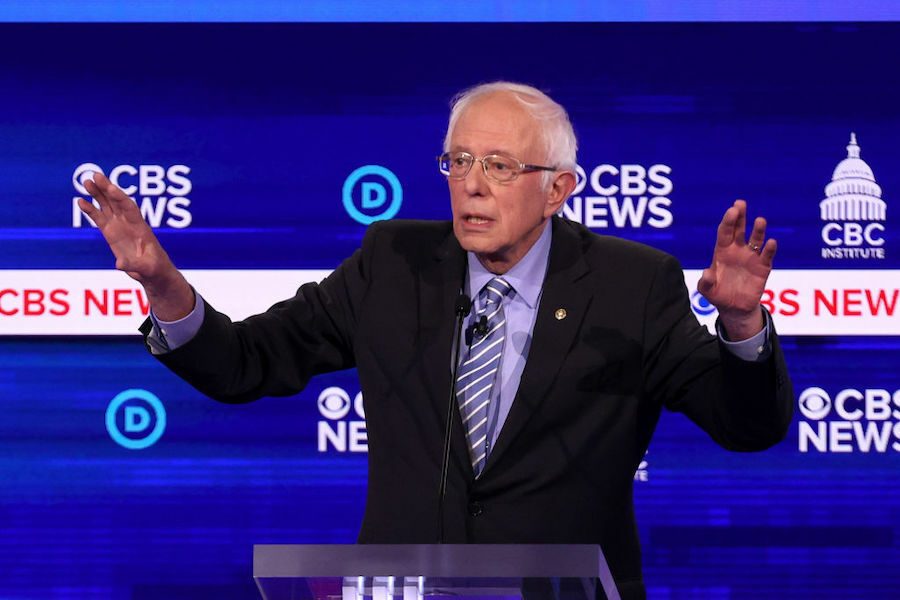This piece is in response to Micah Uetricht’s article, “The Swing Voter Chimera.”
Micah and I agree on many points about how progressives can best win general elections and about the failure of Hillary Clinton’s 2016 campaign. But it is a trap to look at the failure of a moderate campaign, such as Clinton’s, and conclude that progressives should simply do the opposite. To plot a successful course for a progressive candidate like Bernie Sanders, we must move beyond ideological frameworks and address the more nuanced reasons for voter behavior.
Micah and I both reject the simplistic and convenient “moderate swing-voter argument.” Anyone following the major news networks has heard this argument ad nauseum — that elections are decided by moderate swing voters, so winning candidates should position themselves in the ideological middle. The reasoning is not without some merit, because there are certainly moderate swing voters we want to attract. But progressives, especially those who want to win elections in the context of greater movements, should reject this logic not simply because Clinton used this strategy and lost, but because it would undermine our ability to build support for a more progressive agenda.
While many progressives have correctly rejected the moderate swing-voter argument, they have unfortunately replaced it with another simplistic idea, the “progressive argument.” It goes like this: In order to generate the turnout we need to win, we ought to run only on a bold left agenda with bold left rhetoric (to inspire infrequent, or “nontraditional” Democratic voters, to come to the polls). Both arguments fail for the same reason: They view voters purely in ideological terms.
In fact, plenty of evidence indicates that winning over either group — infrequent voters and moderate swing voters — requires going beyond the ideological. FiveThirtyEight estimates that about 7% of voters cast their ballot for one major party in 2012 and the other major party in 2016. Threequarters of these so-called moderate swing voters went for Trump. If they had broken for the more ideologically moderate Clinton, she would likely have won. Simultaneously, infrequent voters did not show up for her. Lower turnout in 2016, especially among African American voters, may equally have cost her the election.
But these supposedly conflicting goals — winning more moderate swing voters and mobilizing infrequent voters — were both accomplished by Barack Obama. And therein lies the key flaw in the logic of the ideologically motivated voting arguments: If ideological positions actually dictated outcomes, one would not expect moderate swing voters to choose the same candidate who inspired infrequent voters to show up. In fact, the voting results for these two groups tend to move up and down together — because neither group votes, broadly speaking, based on ideology.
That means a hyper-ideological campaign is not likely to win over either group. That’s okay. Winning elections, just as building strong movements, requires persuading people who do not believe all the same things we do and, crucially, who are not necessarily motivated by our same motivations. We should never retreat from our values, but the righteousness of our work must still be measured by our ability to effectively engage and win critical fights. There is no virtue in losing a winnable fight on account of a rigid adherence to some orthodoxy or unrelatable political framework.
So what nonideological factors can compel both infrequent and swing voters? Past races show they can be moved by trustworthiness, transparency, independence, anti-establishment credibility or even civility and unity (values oddly maligned by progressives). Progressives can absolutely embrace these values as part of our agenda, which would open more doors to mobilize infrequent voters while gaining trust in the middle, no matter the size of that middle. Indeed, research by sociologists Robb Willer and Jan Voelkel shows that the most effective way to promote progressive policies is in terms of broadly held values, such as family or “the American Dream” — the net result being a broadening of support among moderates and no loss among liberals. When these values are neglected or rejected, we cede them to moderates who typically use them to mask regressive agendas.
The good news for progressives is that these nonideological factors are perfectly compatible with progressive politics — so there is no need to adopt a centrist position that would be anathema to progressive goals (and, frankly, ridiculous for a candidate like Sanders to credibly adopt). Instead, candidates who understand these realities carefully frame progressive agendas in ways that expand their reach.
Sanders masterfully ended the South Carolina debate by answering the question of what people misunderstand about him — pointing out that nothing he is saying is “radical.” His platform has not changed, but to those voters who might be turned off by talk of “political revolution,” he sends reassurance. If Sanders builds on that foundation in the coming months, he will be able to grow far more support among less ideologically motivated voters, all without abandoning a single position. Sanders does not lose his bold progressive credibility because he happens to be trustworthy, or Independent, or anything else.
Progressive movements and campaigns do not succeed by convincing everyone to be radical; they succeed, as Sanders understands, when those ideas are no longer considered radical. Micah is correct that progressives can (and must) win voters beyond our base — but we also must understand that their beliefs and motivations are not always ours, and that’s not a problem as long as we find ways to talk about our agenda, the way they find compelling.
Views expressed are the author’s. As a 501©3 nonprofit, In These Times does not support or oppose any candidate for public office.






